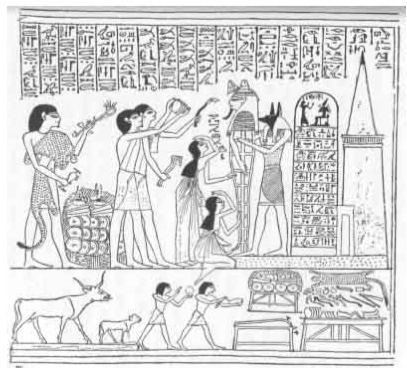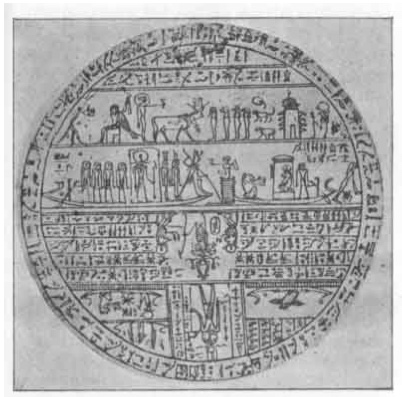Excerpt from the Papyrus of Hunefer, BC 1350
“But it must be remembered that hitherto only the “bull of the south” has been sacrificed, and that the “bull of the north” has yet to be offered up; and all the ceremonies which have been already performed must be repeated if the deceased would have the power to go forth at will over the whole earth.
From the earliest times the South and the North were the two great sections into which the world was divided, and each section possessed its own special gods, all of whom had to be propitiated by the deceased; hence most religious ceremonies were ordered to be performed in duplicate.
In later days each section was divided into two parts, and the four divisions thus made were apportioned to the four children of Horus; hence prayers and formulæ were usually said four times, once in honour of each god, and the rubrical directions on this point are definite.

The ceremony of “opening the mouth” being performed on the mummy of Hunefer, about B.C. 1350 (From the Papyrus of Hunefer, sheet 5)
In the limited space of this book it is not possible to reproduce all the scenes of the ceremony of opening the mouth and the eyes which are depicted in the tombs and elsewhere, but on page 199 is a general view of the ceremony as it is often given in the papyri of the XVIIIth and XIXth dynasties.
On the right we see the pyramidal tomb in the Theban hill with its open door, and by the side of it is the funeral stele with a rounded top inscribed with a figure of the deceased standing in adoration before Osiris, and with a prayer to the god for sepulchral offerings.
Anubis, the god of the dead, embraces the mummy, thus indicating his readiness to take the deceased under his protection.
Nasha, the wife of the deceased, stands weeping before the mummy, and at his feet kneels another weeping woman, probably his daughter.
Anubis and the mummy stand upon a layer of sand which has been placed there with the object of sanctifying the ground.
A priest clad in a panther’s skin holds a censer containing burning incense in one hand, and a vase, from which he sprinkles water, in the other.
One ministrant holds the two instruments “Tun-tet” and “Seb-ur” in the right hand, and the “Ur hekau” instrument in the left; and another offers four vases of unguent.
In the lower register are a cow and her calf, and two men are carrying along to the mummy the haunch which we must assume to have been recently cut from the slaughtered bull, and the heart which has just been taken out of him.
On a table we see lying a number of objects, the “Meskhet,” and Pesh-en-kef,” and other instruments, two sets of four vases for holding unguents and oil, the bags of colour, the iron of the south and north, etc.”
E.A. Wallis Budge, Egyptian Magic, London, 1901. P. 198-202.


